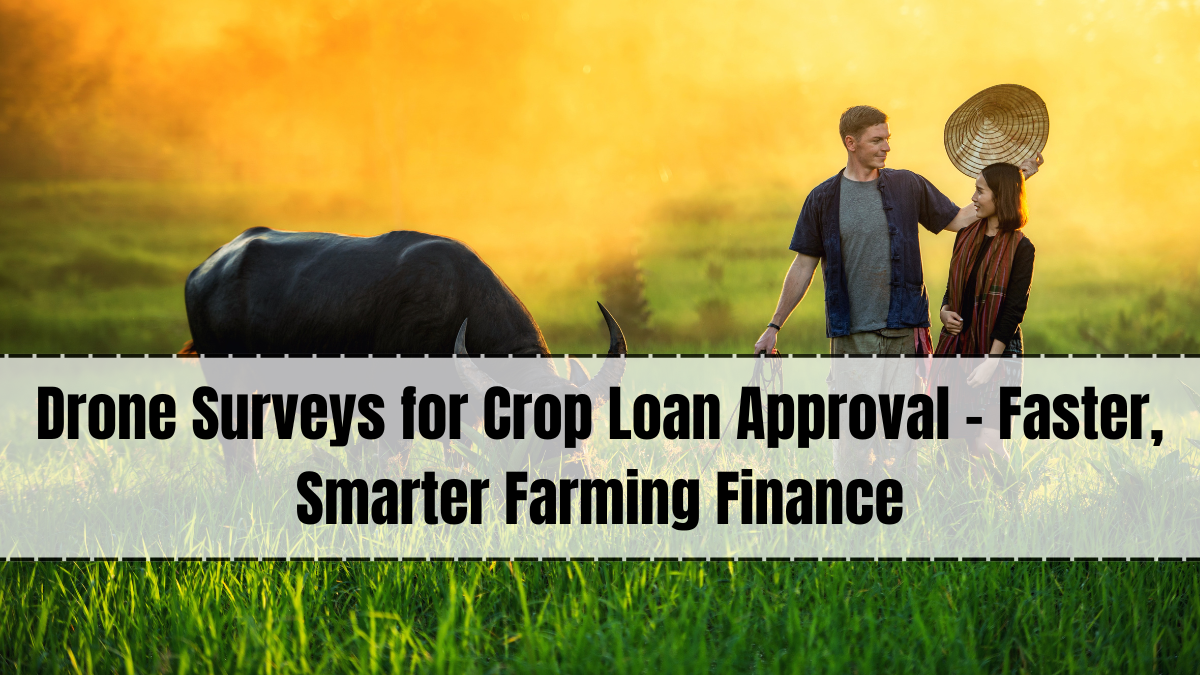In 2025, agriculture is no longer just about soil, seeds, and seasons—it is about harnessing cutting-edge technology to solve age-old problems. One of the most revolutionary tools now helping farmers is drone technology, specifically for speeding up crop loan approvals. Traditionally, securing a crop loan was a long, exhausting process for farmers. They had to navigate layers of paperwork, wait for bank officers to visit their fields, and often face delays that meant missing the ideal planting window. In many cases, by the time the loan amount was sanctioned, the opportunity for optimal crop growth had already passed, forcing farmers to either borrow from informal lenders at high interest rates or reduce cultivation plans.
Drone surveys are changing this story completely. Equipped with high-resolution cameras, GPS tracking, and advanced AI mapping software, agri drones can inspect an entire farm in minutes. They capture accurate data on land boundaries, crop health, and potential yield, and transmit it directly to financial institutions. Instead of weeks of waiting, farmers can now receive approvals within days. This transformation is not just about speed—it’s about transparency, fairness, and ensuring that loans are truly based on the real condition of a farm.

The Limitations of Traditional Loan Approvals
For years, the crop loan approval process depended heavily on manual field inspections by bank or government officers. These inspections were time-consuming, labor-intensive, and often unreliable due to human error or subjective assessment. A bank officer might estimate crop potential differently from another officer, leading to inconsistent loan amounts. Distance and accessibility were also big issues—farms in remote areas could wait even longer for inspections, creating unnecessary delays. Bad weather, road conditions, or scheduling conflicts often slowed down the process even more, sometimes to the point where farmers gave up on formal credit entirely.
How Drone Surveys Transform the Process
Drone surveys for crop loan approval replace manual inspections with a quick, data-driven approach. The process begins with mapping out the farm area to ensure complete coverage. The drone then flies over the land, capturing ultra-high-definition images and videos from multiple angles. In addition to visible light images, some drones use multispectral and thermal cameras to detect crop stress, water availability, and pest infestations.
Once the data is collected, AI-powered software analyzes it to generate a detailed farm report. This report includes accurate measurements of land boundaries, identification of cultivated crops, assessment of growth stages, and yield projections. Because this data is timestamped and stored securely, it serves as an undeniable record for both farmer and lender. Financial institutions can use these reports to decide on loan amounts, interest rates, and repayment schedules with far greater accuracy and confidence.
Benefits for Farmers
The most obvious benefit for farmers is speed. What once took weeks can now be completed in 48–72 hours, meaning farmers can access funds exactly when they need them. Timely credit access is crucial for buying seeds, fertilizers, or renting farm equipment before planting. Drone surveys also ensure that the loan value matches the real productivity potential of the farm, reducing the risk of underfunding.
Another major advantage is fairness. Because drones capture objective, verifiable data, farmers don’t have to worry about biased assessments or incorrect measurements. In disputes, they can refer to the drone-generated report as proof of their farm’s actual condition. This increased transparency builds trust between farmers and lenders, encouraging more farmers to apply for formal credit instead of turning to costly informal loans.
Advantages for Lenders
Banks, microfinance institutions, and cooperative societies also benefit greatly from drone-based loan verification. By eliminating the need for manual inspections, they save on travel expenses, staff time, and administrative costs. The higher accuracy of drone data reduces the risk of lending to unqualified applicants, thereby lowering default rates. Additionally, the availability of historical drone data allows lenders to track changes in a farm’s productivity over time, enabling better loan restructuring or targeted support if needed.
Integration with Other Agri-Tech Solutions
In many regions, drone surveys are being integrated with other advanced agricultural technologies for an even more efficient loan process. For example, IoT sensors in the soil can complement drone data by providing information about soil moisture and nutrient content. Weather forecast systems can help lenders anticipate risks, while blockchain platforms can securely store all loan-related data for future reference. This interconnected system makes agricultural financing smarter, more secure, and more responsive to real-world farming conditions.
Real-World Success Stories
Pilot projects in states like Maharashtra, Punjab, and Andhra Pradesh have shown remarkable results. In Maharashtra, a state cooperative bank partnered with a drone services company to process over 200 crop loan applications in under a week. In Punjab, drone surveys have been used to assess damage after floods, enabling faster relief funding for affected farmers. These examples show that drone-based verification is not just theoretical—it is already delivering tangible benefits.
Challenges in Adoption
Despite its potential, the widespread use of drone surveys for crop loan approval faces some challenges. Rural internet connectivity remains a hurdle, as transmitting high-resolution images requires stable bandwidth. There is also a need for farmer education so they understand how drone surveys work and why they can trust the results. Initial investment in drones and training can be costly for smaller banks, though many are exploring partnerships with drone service providers to reduce costs.
FAQs
What are drone surveys for crop loan approval?
They are aerial inspections of farmland using drones equipped with cameras and sensors to gather accurate data for loan processing.
How do drone surveys speed up loan approvals?
They eliminate the need for manual inspections, providing lenders with real-time, verified farm data within days instead of weeks.
Are drone surveys accurate for small farms?
Yes, drones can map and assess even small plots of land with high precision.
Can this technology reduce fraud in agriculture loans?
Yes, because the data is time-stamped, geotagged, and tamper-proof, making it difficult to misrepresent land size or crop status.
Is this system already in use in India?
Yes, several states are running pilot projects, and adoption is expected to grow rapidly in 2025.
Click here to know more.
